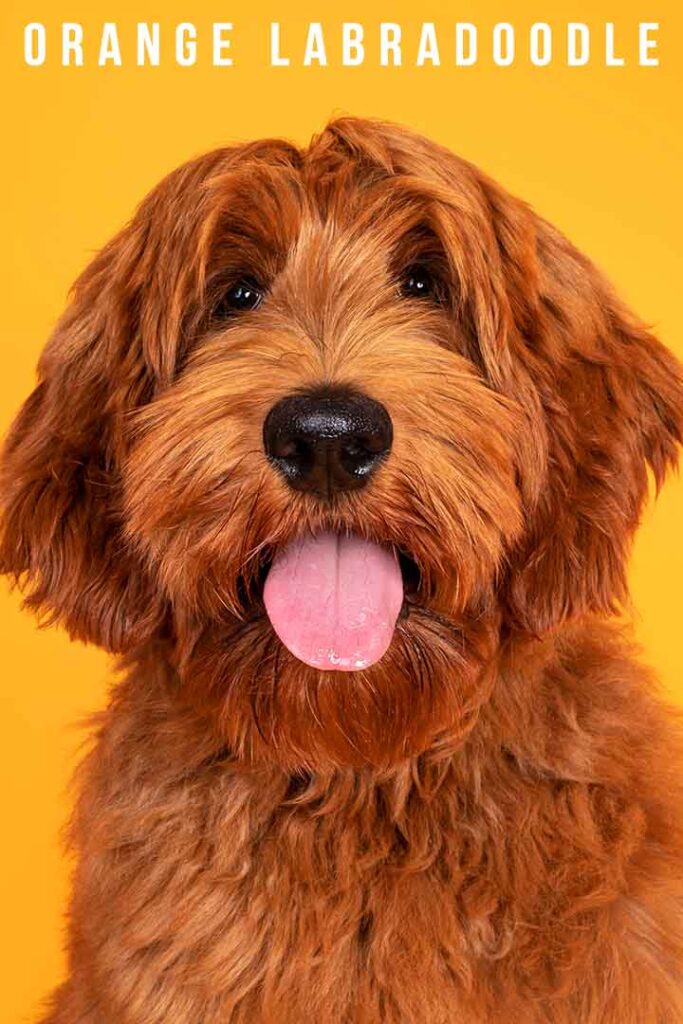This complete guide to the orange Labradoodle takes a closer look at Doodle colors and care, so you’re fully prepared to bring home an orange Labradoodle puppy!
- What do orange Labradoodles look like?
- Do orange Labradoodles change color?
- Orange Labradoodle grooming and shedding
- Finding an orange Labradoodle puppy
Orange isn’t an official color for Labradoodles. But, it is a term that can be used to describe coat colors like apricot, red, and gold. An orange Labradoodle might have curly or straight fur – it will depend on which parent they favour and their generation. When looking for an orange Doodle puppy, it’s a great idea to use some of the official color names, to find a wider range of breeders.
The Orange Labradoodle
Labradoodles are a popular mix between purebred Labrador Retrievers and Poodles. Australian Labradoodles are similar, but can have genetic influence from up to 4 other purebred dog breeds. Their traits can vary massively from one puppy to another, since it will all depend on the genes they inherit! Some might look like the perfect mix, but others may favor one of their purebred parents. In later generations, breeders can specialise in certain traits.
The purebred Labrador is available in only three official colors: black, yellow, and chocolate. But, Poodles have a much wider variety of shades. The closest official Poodle colors to orange are red and apricot. So, even a first generation Labradoodle mix, one with two purebred parents, can inherit orange fur. Especially if breeders combine a red or apricot Poodle with a yellow or brown Lab! Exact shades will vary, so all Labradoodles will be unique!
What Do Orange Labradoodles Look Like?
The exact appearance of an orange Labradoodle will depend on what traits they inherit. Labradoodles can come in three sizes, with standard Labradoodles being the largest, miniature Labradoodles the smallest, and medium Labradoodles falling somewhere in between. They will have a long tail, healthy muzzle, and floppy ears. But, their fur type can also vary between three types:
- Hair type – these Doodles have straight hair, very similar to a purebred Lab. They will have a double layer coat, and may have some slight waviness, but not much.
- Fleece type – these Labradoodles will have wavy fur or very loose curls. Their fur is very soft to the touch, often described to feel like angora wool.
- Wool type – these Labradoodles have the curliest fur. Their fur will be single layered, similar to the purebred Poodle, and will feel coarse to the touch.
Coat type will become more obvious once a Labradoodle sheds their puppy coat. But, experienced breeders are often good at breeding for certain traits, like a low shedding fleece or wool coat.
Orange Labradoodle Generations
First generation mixes are mixed breed dogs with two purebred parents. These are often the least predictable of all generations, because their parents are usually the most different from one another! But, even f1 Labradoodles can have orange fur thanks to the influence of Poodle DNA. Purebred Poodles can come in red and apricot, which can both look very orangey! It’s entirely possible for a Labradoodle to inherit these shades, even if they are a first generation.
In later generations, breeders can choose to breed two Labradoodles with similar traits. This will increase the likelihood of puppies inheriting those traits. So, if you want an orange Labradoodle, or one with curlier fur, you might be better off choosing an f2, f1b, or multigen Labradoodle.
Do Orange Labradoodles Change Color?
Labradoodles have a puppy coat which will shed away in their first year to reveal their adult coat. Their adult fur may look slightly different to this puppy coat. So, some Labradoodles may change color slightly. You could look to bring home a rescue dog, or just a slightly older Labradoodle to avoid this change.
Purebred Poodles of all sizes can also be affected by a gene known as the greying gene. This gene causes dogs to turn prematurely grey. It primarily affects black and brown coloring (from the eumelanin pigment), rather than red. So, an orange Labradoodle wouldn’t usually experience this problem. But, in rare cases, it may occur, and of course, a brown Labradoodle with an orangey tint could experience premature greying!
Orange Labradoodle Grooming
The best grooming method for an orange Labradoodle will vary depending on their coat type. Hair Labradoodles have straight, dense fur. This fur type is most similar to the Labrador, and has the lowest grooming needs. But, regular grooming can help you keep on top of shedding. Orange Labradoodle owners may want to invest in a good quality slicker brush, to give their Doodle a regular once-over.
Wool coat type Labradoodles are at the other end of the grooming spectrum. They have very high grooming needs, because the curls in their coat can tangle much more easily. This could happen because of trapped shedding furs, or even just their daily activity and movements. They will need to be groomed once a day, to prevent any knots or tangles from turning into matted fur. If you let your Labradoodle’s fur become too matted, it will be painful and may need to be shaved off completely.
Fleece coat Labradoodles will fall somewhere in between these two extremes. The frequency of grooming and the best tools for the job will depend entirely on your dog’s coat. So, you might want to seek tips and advice from a groomer near you!

Are Orange Labradoodles Hypoallergenic?
Labradoodles are often sold as hypoallergenic dogs, meaning they won’t trigger allergy symptoms in their owners. However, there’s no guarantee that this is the case! In fact, some studies have found no difference in allergen levels between “hypoallergenic” and non hypoallergenic dogs.
Hair type Labradoodles can also shed just as much as a Labrador. So, you will come into contact with allergens in their dander and saliva-coated hairs around the house. The lowest shedding Labradoodle type is one with a wool coat. But, this type also requires the most grooming, so you’ll have to get up close to their fur and dander very frequently.
Allergen levels can vary from one dog to the next, no matter what their fur color. So, it can help to spend some time with your Labradoodle before bringing them home, and see if they trigger your symptoms.
Finding an Orange Labradoodle Puppy
Since orange isn’t an official Labradoodle color, you might struggle to find puppies using that term! But, you’ll get plenty of results if you search colors like apricot, gold, or red. These shades will vary quite a lot, so take your time finding a puppy with the coloring you like, and bear in mind that their color may change slightly as they grow. Choosing an older rescue dog can make finding your perfect fur shade easier.
Above all else, when buying a puppy you must find a reputable breeder. Reputable breeders will prioritise health and care above all else. Labradoodles are very popular, so there are a lot of backyard breeders and puppy mills trying to make a quick profit. Puppies from these places will usually be less healthy, poorly treated, and may have behavioral issues from their upbringing.
Ask plenty of questions when you visit a breeder, take a look at the puppies and where they are kept, and make sure you see evidence of health testing. If you have any doubts, don’t be afraid to walk away and continue your search elsewhere!
Orange Labradoodle – A Summary
Though orange isn’t an official Labradoodle color, there are plenty of Labradoodle puppies with orange fur, or an orange hue! So, it won’t take you long to find your dream puppy. This fur color won’t impact your Labradoodle’s personality. But, make sure you’re ready for any outcome, especially if you’re choosing a first generation mix.
Do you have an orange Labradoodle puppy at home? Let us know what they’re like in the comments!
Readers Also Liked
- Labradoodle Hair Types
- Red Australian Labradoodle
- Apricot Labradoodle
- Tan Labradoodle
References and Resources
- ‘Greying G Series’, Dog Genetics
- Brancalion, L. (et al), ‘Canine Coat Pigmentation Genetics: A Review’, Animal Genetics (2021)
- Schmutz, S. & Berryere T. ‘Genes Affecting Coat Color and Pattern in Domestic Dogs: A Review’, Animal Genetics (2007)
- Vredegoor, D. (et al), ‘Can f 1 Levels in Hair and Homes of Different Dog Breeds: Lack of Evidence to Describe Any Dog Breed as Hypoallergenic’, Journal of Allergy and Clinical Immunology (2012)
- Nicholas, C. (et al), ‘Dog Allergen Levels in Homes with Hypoallergenic Compared with Nonhypoallergenic Dogs’, American Journal of RHinology & Allergy (2011)
- Chan, S. & Leung, D. ‘Dog and Cat Allergies: Current State of Diagnostic Approaches and Challenges’, Allergy, Asthma and Immunology Research (2018)
- Miller, R. ‘Differentiation of the Can f 1 Allergen in Hypoallergenic Dog Saliva Compared to Shedding Dog Saliva’, Honors College Theses (2021)

